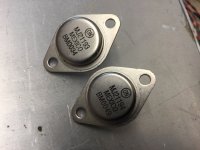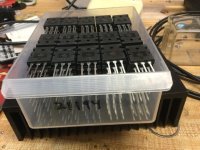I retract my comment,
BUT 15021 looks weird.
Wg_ski, no matter how you hold the camera, those transistors look different to me.
The font, the distances between the letters, E touching X.
BUT 15021 looks weird.
Wg_ski, no matter how you hold the camera, those transistors look different to me.
The font, the distances between the letters, E touching X.
I still think the smearing and perspective is an optical illusion, brought on by relative camera angles between the two. And no marking system is perfect, even if laser etched into an epoxy case. These things go through FAST assembly lines. I’ve seen slight differences in the same tray, which were all done in one batch. If one is real the other is. The only thing that makes me question it at all is the fact that MJ15020 and 021 were NLA through distribution by 2001. That doesnt mean there was no factory stock left, or that last time OEM buys were not possible. You just couldn’t get them from Newark anymore. When they actually QUIT making them is unknown.
They aren’t that widely available to begin with. Not everybody carried them but they were designed into a lot of high end and PA stuff. They were the slightly lower power/current high speed 20 MHz DRIVER set specifically for the MJ15024/5 family. So were the MJ15026/7 - a direct 24 MHz version of the MJ15024/5 with the same SOA - which were NEVER available through distribution but there was a data sheet.
They aren’t that widely available to begin with. Not everybody carried them but they were designed into a lot of high end and PA stuff. They were the slightly lower power/current high speed 20 MHz DRIVER set specifically for the MJ15024/5 family. So were the MJ15026/7 - a direct 24 MHz version of the MJ15024/5 with the same SOA - which were NEVER available through distribution but there was a data sheet.
Nowadays I would only order power transistors from suppliers who can guarantee that they come from the factory whose logo I see from the outside. Many suppliers cannot do this because they order from various major suppliers - but not from the manufacturer itself.
Sanken once informed me that this supplier under
https://eu.profusion.uk/de_en/industrial/discr-semi/transistors
always purchases directly there.
This means you can't get unwanted counterfeits on the desk and therefore don't experience any unexpected surprises while repair service.
Concerning ONSEMI I have heard, Mouser and DigiKey are the right suppliers, because this suppliers also purchases always directly there.
But this I don't know exactly.
P.S.:
What about the quality of this manufacturer from Taiwan:
http://www.mospec.com.tw/eng/power/p16.htm
Sanken once informed me that this supplier under
https://eu.profusion.uk/de_en/industrial/discr-semi/transistors
always purchases directly there.
This means you can't get unwanted counterfeits on the desk and therefore don't experience any unexpected surprises while repair service.
Concerning ONSEMI I have heard, Mouser and DigiKey are the right suppliers, because this suppliers also purchases always directly there.
But this I don't know exactly.
P.S.:
What about the quality of this manufacturer from Taiwan:
http://www.mospec.com.tw/eng/power/p16.htm
Last edited:
I’ve always wanted to get my hands on some MJ15020/21, and if I found some for sale somewhere I’d simply take the chance. Ditto for MJ15011/12 (2SD555/B600 equivalents). They are NOT going to come from distribution channels - they were hard enough to get when Motorola MADE them. Its almost as if they didn’t WANT the lay person to get ahold of the higher speed drivers. Sure you can just buy them NOW, but not in a TO-3 that will just drop into a vintage amp with giant heat sinks drilled for banks of TO-3’s. The only people that managed THAT was Krell, and Motorola made them buy millions of MJ3281. They’re going to hold on to the remaining stock FOREVER. They might show up on E-bay in say 50 years. And so will the fakes.
If I wanted MJ21193 I’d just go to the bin I have and pick a few out. No need to BUY anything.
If I wanted MJ21193 I’d just go to the bin I have and pick a few out. No need to BUY anything.
Last edited:
I don't understand the marked termIf I wanted MJ21193 I’d just go to the bin I have and pick a few out.
Hi as_audio,
I don't know ... I have some output transistor types I bought 100 of at the time. For signal types, my normal purchase quantity was 100 pcs of each type. Thankfully I've been able to go through most power types.
Hi tiefbassuebertr,
If you go to the manufacturer's site, they will list their authorized distributors. He is saying he has them stored and on hand.
I don't know ... I have some output transistor types I bought 100 of at the time. For signal types, my normal purchase quantity was 100 pcs of each type. Thankfully I've been able to go through most power types.
Hi tiefbassuebertr,
If you go to the manufacturer's site, they will list their authorized distributors. He is saying he has them stored and on hand.
Pretend, no. But this is how many remain out of 100 each, obtained for free through a university program - hot off the production line. My buddy who was still in school at the time got these for us and we split them. By comparison I have a few more of the flatpacks on hand, because my newer 4k design uses them. All those purchased from authorized distributors, back when they were about two bucks each. Some are even the new G type. You can see the different finish on the leads. Should be enough to last the rest of my life. At todays prices they’ll have to.
Attachments
Thank you all for replies.
I have done some basic measurements. Here are results in pictures of low current hFE and base-emmiter capacitance:




B-E capacitance:


When I reverse probes, capacitance is about 1 nF less.
Finally, I took better pictures of transistors:


These are basic tests that I have done.
What do you all think?
Thanks in advance
Ivo
I have done some basic measurements. Here are results in pictures of low current hFE and base-emmiter capacitance:
B-E capacitance:
When I reverse probes, capacitance is about 1 nF less.
Finally, I took better pictures of transistors:
These are basic tests that I have done.
What do you all think?
Thanks in advance
Ivo
Font and appearance of those transistors above look very much alike my MJ15001 and MJ15002 bought from a reliable major supplier in the past. This includes some of the characters painted thicker than others.
Now just a funny one in between: are these fake hairpins, fake transistors, or both? 🙂

Now just a funny one in between: are these fake hairpins, fake transistors, or both? 🙂
Those are fine. 5000 pf is right where they ought to be, as is the just under 600 mV vbe.
You get a little different capacitance both ways because there is probably a small DC bias from rectification. As the reverse voltage increase, capacitance decreases.
And low current hFE of the NPN is below that of the PNP, which is as it should be. They become more equal at an amp or two, and fall again (together) at currents approaching 10 amps.
You get a little different capacitance both ways because there is probably a small DC bias from rectification. As the reverse voltage increase, capacitance decreases.
And low current hFE of the NPN is below that of the PNP, which is as it should be. They become more equal at an amp or two, and fall again (together) at currents approaching 10 amps.
The entire tray of them is screen printed at once, and it looks like it wasnt quite dry when they peeled it up - the end smeared. It originally looked like a camera angle thing but with them level you can see better.Font and appearance of those transistors above look very much alike my MJ15001 and MJ15002 bought from a reliable major supplier in the past. This includes some of the characters painted thicker than others.
But the ink is supposed to be impervious to isopropyl alcohol and other commonly used cleaners. Even on the ancient aluminum case stuff. Very easy to check and verify for yourself - I always have some on hand for getting heat sink grease off of stuff.
The fakers have also NEVER gotten a good hermetic seal on the top hats. With just a little modest pressure with a pair of pliers and almost no deformation they pop right off. You cant get real ones off without bending them to pieces or cutting them off with a hacksaw.
I wish this would be an easy indicator for the authenticity of transistors, but it's not. I have a bunch of good old Sony VFETs, which are the real thing, but the ink likes to come off just from touching the parts with my fingers.But the ink is supposed to be impervious to isopropyl alcohol and other commonly used cleaners.
Hi mbrennwa,
I'll believe you they are legitimate. I am surprised though. Semis have always had markings that were tough to remove. The early fake ones came off easily before they figured that out. I have to say I am surprised as it's common to have to remove grease, dust and (back then) cigarette smoke deposits. Methyl Hydrate was the best for that cleaning job.
I'll believe you they are legitimate. I am surprised though. Semis have always had markings that were tough to remove. The early fake ones came off easily before they figured that out. I have to say I am surprised as it's common to have to remove grease, dust and (back then) cigarette smoke deposits. Methyl Hydrate was the best for that cleaning job.
Motorola/ON ink formulation has always been impervious to cleaners. It’s so the marking doesnt come off when washing PCBs in the factory. Using stuff that was banned in the rest of the world long before it was banned in the states. It certainly doesn’t mean everybody’s was. In a good portion of the world the only legal cleaners are DI water and compressed air.
Eventually it will rub off. I’ve got some old stock that’s pretty scratched up.
Eventually it will rub off. I’ve got some old stock that’s pretty scratched up.
I have just tried to rub lettering with high percentage alcohol and lettering stays as before - not a tiny bit was removed nor ink faded. Lettering is exactly the same after 'cleaning' with tissue with alcohol on it.
I would not like to try with some other chemicals, like acetone (nail polish remover) or anything else. I hope that alcohol test is enough for testing lettering ink.
I would not like to try with some other chemicals, like acetone (nail polish remover) or anything else. I hope that alcohol test is enough for testing lettering ink.
- Home
- Design & Build
- Parts
- My Transistors, original or copy?


